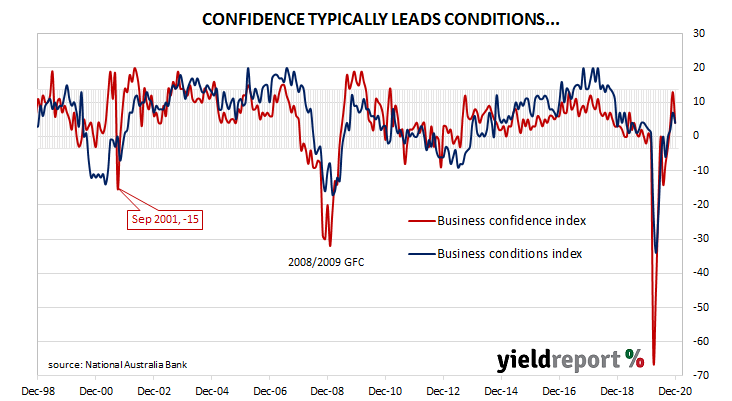Summary: Business conditions improve but confidence falls in December; suggests “strong momentum”; Sydney outbreak “likely” driver of confidence fall; capacity usage rate increases again; “upside risk” to ANZ’s forecasts; RBA expected to maintain stimulatory policy settings.
NAB’s business survey indicated Australian business conditions were robust in the first half of 2018, with a cyclical-peak reached in April of that year. Readings from NAB’s indices then began to slip, declining to below-average levels by the end of 2018. Forecasts of a slowdown in the domestic economy began to emerge in the first half of 2019 and the indices trended lower, hitting a nadir in April 2020 as pandemic restrictions were introduced. Conditions have improved markedly since then.
According to NAB’s latest monthly business survey of over 550 firms conducted around the middle of January, business conditions improved for a fourth consecutive month. NAB’s conditions index registered 14, up from December’s revised reading of 7.
“Business conditions are now well above average, suggesting there is strong momentum in Australia’s economic recovery,” said NAB chief economist Alan Oster.
In contrast, business confidence deteriorated. NAB’s confidence index declined from November’s revised reading of +13 to +4. Typically, NAB’s confidence index leads the conditions index by approximately one month, although some divergences have appeared in the past from time to time.
Oster suggested “this likely reflects the impact of the Sydney COVID-19 outbreak through December” although he also noted confidence levels had fallen in Victoria and Queensland as well.
Longer-term Commonwealth Government bond yields moved inconsistently on the day. By the end of the day, the 10-year ACGB yield had gained 3bps to 1.10% while the 20-year yield lost 3bps to 1.82%. The 3-year yield remained unchanged at 0.18%.
In the cash futures market, expectations of a change in the actual cash rate, currently at 0.03%, remained fairly stable. At the end of the day, contract prices implied the cash rate would inch up slowly to around 0.06% by mid-2022.

